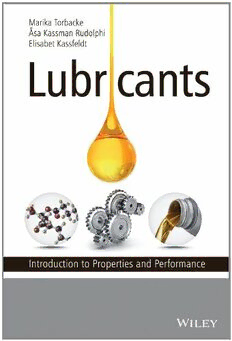
Lubricants: Introduction to Properties and Performance PDF
Preview Lubricants: Introduction to Properties and Performance
Marika Torbacke Åsa Kassman Rudolphi Elisabet Kassfeldt Lubr cants Introduction to Properties and Performance LUBRICANTS LUBRICANTS INTRODUCTION TO PROPERTIES AND PERFORMANCE MarikaTorbacke StatoilLubricants,Sweden ÅsaKassmanRudolphi UppsalaUniversity,Sweden ElisabetKassfeldt Lulea˚ UniversityofTechnology,Sweden Thiseditionfirstpublished2014 ©2014JohnWiley&SonsLtd Registeredoffice JohnWiley&SonsLtd,TheAtrium,SouthernGate,Chichester,WestSussex,PO198SQ,UnitedKingdom Fordetailsofourglobaleditorialoffices,forcustomerservicesandforinformationabouthowtoapplyfor permissiontoreusethecopyrightmaterialinthisbookpleaseseeourwebsiteatwww.wiley.com. TherightoftheauthortobeidentifiedastheauthorofthisworkhasbeenassertedinaccordancewiththeCopyright, DesignsandPatentsAct1988. Allrightsreserved.Nopartofthispublicationmaybereproduced,storedinaretrievalsystem,ortransmitted,inany formorbyanymeans,electronic,mechanical,photocopying,recordingorotherwise,exceptaspermittedbytheUK Copyright,DesignsandPatentsAct1988,withoutthepriorpermissionofthepublisher. Wileyalsopublishesitsbooksinavarietyofelectronicformats.Somecontentthatappearsinprintmaynotbe availableinelectronicbooks. Designationsusedbycompaniestodistinguishtheirproductsareoftenclaimedastrademarks.Allbrandnamesand productnamesusedinthisbookaretradenames,servicemarks,trademarksorregisteredtrademarksoftheir respectiveowners.Thepublisherisnotassociatedwithanyproductorvendormentionedinthisbook. LimitofLiability/DisclaimerofWarranty:Whilethepublisherandauthorhaveusedtheirbesteffortsinpreparing thisbook,theymakenorepresentationsorwarrantieswithrespecttotheaccuracyorcompletenessofthecontentsof thisbookandspecificallydisclaimanyimpliedwarrantiesofmerchantabilityorfitnessforaparticularpurpose.Itis soldontheunderstandingthatthepublisherisnotengagedinrenderingprofessionalservicesandneitherthe publishernortheauthorshallbeliablefordamagesarisingherefrom.Ifprofessionaladviceorotherexpert assistanceisrequired,theservicesofacompetentprofessionalshouldbesought. LibraryofCongressCataloging-in-PublicationDataappliedfor. ISBN9781118799741 Setin10/12ptTimesbyAptaraInc.,NewDelhi,India 1 2014 Contents Preface xi ListofSymbols xiii ListofTables xvii PartOne LUBRICANTPROPERTIES 1 IntroductiontoTribology 3 1.1 TribologicalContacts 5 1.1.1 MacroscaleContacts 6 1.1.2 MicroscaleContacts 8 1.2 Friction 8 1.2.1 TheCoefficientofFriction 8 1.2.2 LubricationRegimes 10 1.3 Wear 12 1.3.1 WearRate 13 1.4 LubricationoftheTribologicalSystem 14 1.4.1 ThePurposesofLubricants 14 1.4.2 ReducingFrictionandProtectingagainstWear 15 1.4.3 Semi-SolidLubricants 16 1.4.4 SolidLubricantsandDryLubricants 16 References 17 2 LubricantProperties 19 2.1 PerformanceProperties 20 2.1.1 Viscosity 20 2.1.2 LowandHighTemperaturePropertiesofLubricants 27 2.1.3 AirandWaterEntrainmentProperties 29 2.1.4 ThermalProperties 32 2.2 LongLifeProperties 33 2.2.1 TotalAcidNumber(TAN) 34 2.2.2 TotalBaseNumber(TBN) 35 2.2.3 OxidationStability 35 vi Contents 2.2.4 HydrolyticStability 37 2.2.5 CorrosionInhibitionProperties 37 2.3 EnvironmentalProperties 40 2.3.1 EnvironmentallyAdaptedLubricants 40 2.3.2 MarketProductswithaReducedEnvironmentalImpact 41 2.4 SummaryofAnalyses 42 References 44 3 BaseFluids 45 3.1 GeneralHydrocarbonChemistry 45 3.2 BaseFluidCategorization 48 3.3 TheRefiningProcessofCrudeOils 50 3.3.1 TheRefiningProcess 51 3.3.2 InfluenceoftheRefiningProcessontheOilProperties 52 3.4 BaseFluidsOriginatingfromCrudeOil 53 3.4.1 ParaffinicBaseOils 53 3.4.2 NaphthenicBaseOils 53 3.4.3 WhiteOils 54 3.4.4 VeryHighViscosityIndexBaseOils 54 3.4.5 Polyalphaolefins 54 3.4.6 Gas-to-LiquidBaseFluids 55 3.4.7 Re-RefinedBaseOils 56 3.5 BaseFluidsOriginatingfromRenewableRawMaterials 56 3.5.1 VegetableOils(NaturalEsters) 57 3.5.2 SyntheticEsters 57 3.6 NonconventionalSyntheticBaseFluids 59 3.7 PropertiesofBaseFluids 59 References 61 4 Additives 63 4.1 FundamentalConceptsandProcesses 63 4.1.1 AtomsandReactions 63 4.1.2 IntermolecularForces 64 4.1.3 ChemicalPotential 66 4.1.4 Surfaces 66 4.1.5 MassTransfer 67 4.1.6 Adsorption 68 4.1.7 ChemicalCharacteristicsofSurfaceActiveAdditives 70 4.2 AdditiveExploration 71 4.3 SurfaceActiveAdsorbingAdditives 73 4.3.1 CorrosionInhibitors 73 4.3.2 FrictionModifiers 75 4.3.3 AntiwearAdditives 75 4.3.4 ExtremePressureAdditives 76 4.3.5 ActivationofAntiwearandExtremePressureAdditives 77 4.3.6 CompetitionforSurfaceSitesbySurfaceActiveAdditives 78 Contents vii 4.4 InterfacialSurfaceActiveAdditives 79 4.4.1 Defoamers 79 4.4.2 EmulsifiersandDemulsifiers 80 4.5 PhysicallyBulkActiveAdditives 81 4.5.1 ViscosityModifiers 81 4.5.2 PourPointDepressants 82 4.5.3 Dispersants 84 4.6 ChemicallyBulkActiveAdditives 85 4.6.1 Detergents 85 4.6.2 Antioxidants 87 4.7 AdditiveSummary 88 References 89 PartTwo LUBRICANTPERFORMANCE 5 FormulatingLubricants 93 5.1 GeneralAspectsofDevelopment 93 5.1.1 Formulations 93 5.1.2 DevelopmentWork 96 5.1.3 MaterialCompatibility 96 5.1.4 Miscibility 97 5.1.5 InteractionsinaLubricatedContact 97 5.2 QualityoftheLubricatedTribologicalContact 98 5.2.1 LubricantFilmRegime 99 5.2.2 MaintainingaHighQualityContact 101 5.3 Hydraulics 101 5.3.1 DescriptionofaHydraulicSystem 101 5.3.2 FormulatingHydraulicOils 102 5.4 Gears 104 5.4.1 DescriptionofGears 104 5.4.2 FormulatingGearOils 105 5.5 CombustionEngines 107 5.5.1 DescriptionofCombustionEngines 107 5.5.2 FormulatingCombustionEngineOils 108 References 110 6 TribologicalTestMethods 113 6.1 Field,BenchandComponentTests 113 6.2 ModelTests 115 6.2.1 StrategyforSelectingandPlanningaModelTest 115 6.3 LubricantFilmThicknessMeasurements 117 6.3.1 ElectricalMethods 117 6.3.2 OpticalInterferometryMethod 118 6.4 TribologicalEvaluationinMixedandBoundaryLubrication 121 6.4.1 ThePin-on-DiscTribotest 121 viii Contents 6.4.2 TheReciprocatingTribotest 123 6.4.3 TheTwinDiscTribotest 124 6.4.4 TheRotaryTribotest 128 6.5 SelectionofModelTeststoSimulateRealContacts 128 6.5.1 Hydraulics 129 6.5.2 Gears 129 6.5.3 CombustionEngines 131 6.6 SummaryofTribotestMethods 131 References 132 7 LubricantCharacterization 133 7.1 GeneralCharacterizationConcepts 133 7.1.1 Planning 133 7.1.2 BasicMixingTheory 134 7.1.3 Sampling 135 7.1.4 DilutingtheSample 136 7.1.5 CollectingAnalysisData 137 7.1.6 CalculationsandEvaluation 138 7.2 ConditionAnalysesofLubricants 138 7.3 NonusedOilCharacterization 140 7.3.1 Development 140 7.3.2 Production 141 7.3.3 ApplicationExamples 142 7.4 UsedOilCharacterization 142 7.4.1 SelectionofAnalyses 143 7.4.2 AnalysisExamplesofSelectedApplications 144 7.5 SummaryofUsedOilAnalyses 146 References 148 8 SurfaceCharacterization 149 8.1 SurfaceCharacterizationofRealComponents 151 8.1.1 ExaminationofNonusedSurfaces 151 8.1.2 ExaminationofUsedSurfaces 151 8.1.3 CharacteristicsofApplicationExamples 152 8.2 MicroscopyTechniques 153 8.2.1 VisualInspection 153 8.2.2 LightOpticalMicroscopy(LOM) 154 8.2.3 OpticalInterferenceMicroscopy 154 8.2.4 AtomicForceMicroscopy(AFM) 154 8.2.5 ScanningElectronMicroscopy(SEM) 155 8.2.6 FocusedIonBeam(FIB) 158 8.2.7 TransmissionElectronMicroscopy(TEM) 159 8.3 SurfaceMeasurement 159 8.3.1 StatisticalSurfaceParameters 161 8.3.2 ContactingStylusProfiler 162 8.3.3 MicroscopyTechniques 163
